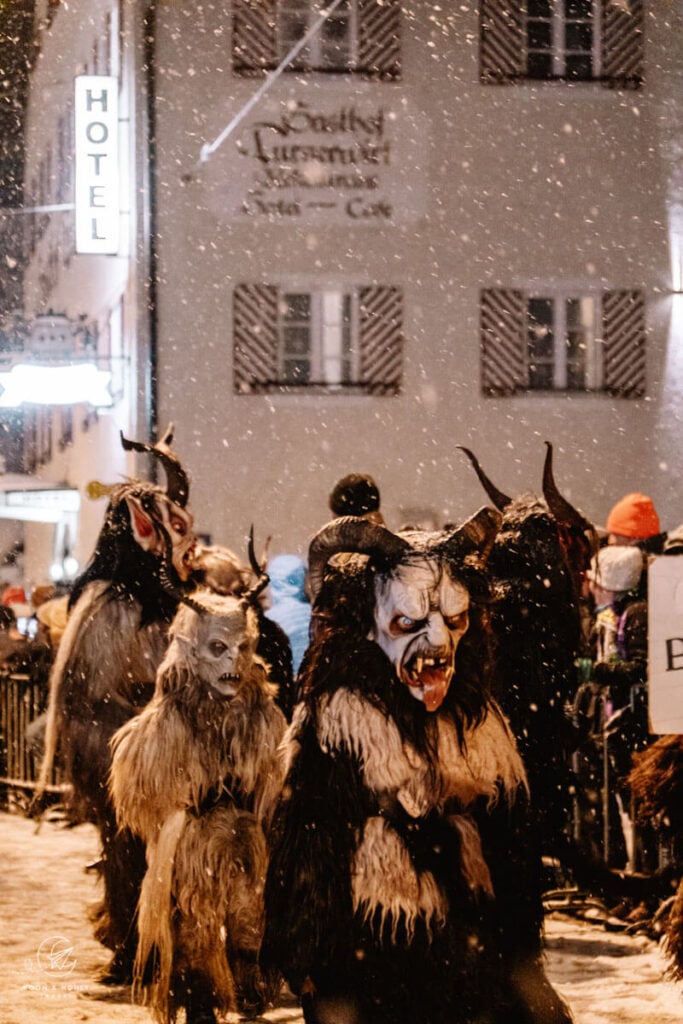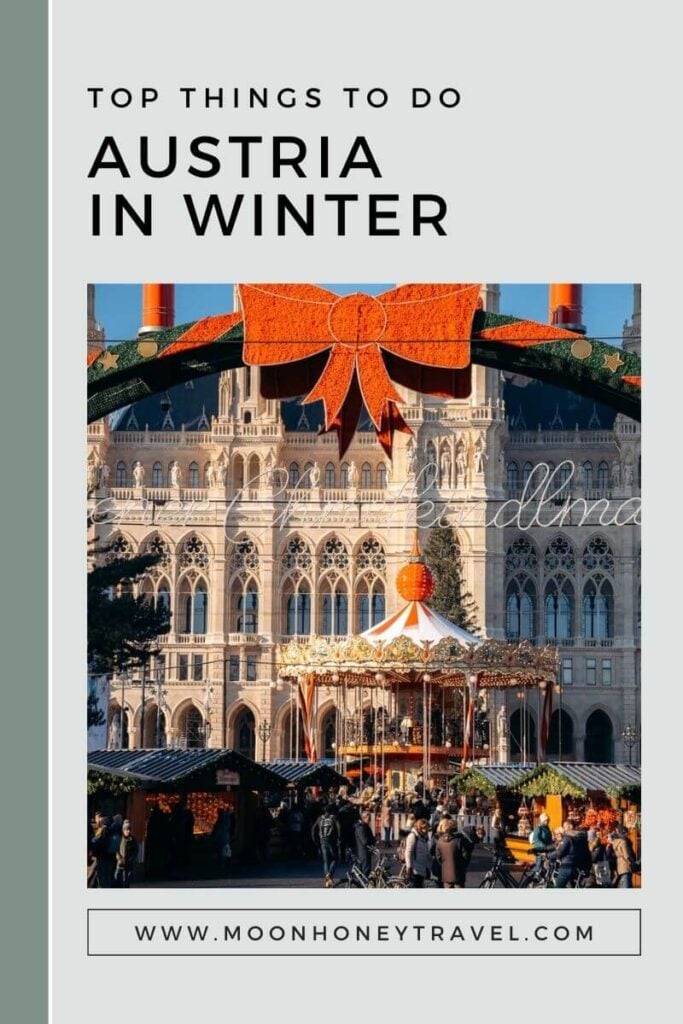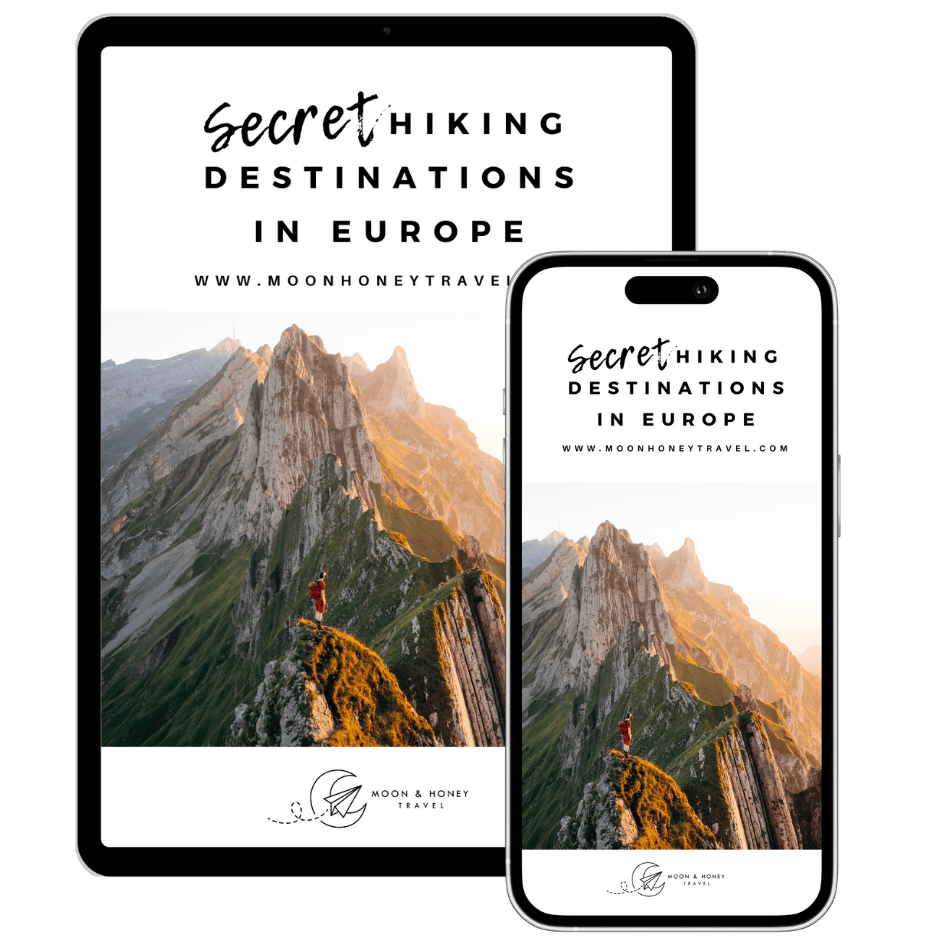Winter in Austria commences in December and ends in early April. Winter is the season of Christmas markets, Krampus Runs, Skiing and winter sports, thermal baths, Fasching (Carnival), and numerous winter solstice traditions.
It’s a culturally-rich season to visit Austria and experience the Austrian way of life.
This Austria winter guide is crafted from a wealth of firsthand experiences garnered from living in Austria for years. And of course, Kati is Austrian.
Here’s what we do and what we look forward to each winter in Austria.

- Winter Season: December – March (April)
- Top Austrian Cities To Visit in Winter: Salzburg, Vienna, Graz, and Innsbruck
- Top Ski Resorts: St. Anton am Arlberg, Lech am Arlberg, Obertauern, Ischgl, Saalbach-Hinterglemm, Sölden, and Kitzbühel
- Getting Around in Winter: We recommend using public transit to travel across Austria in winter. If you want to travel by car, use the Discovercars.com car rental platform to search for and book car rentals.
- Accommodation Booking: We book all our hotels and accommodations using the user-friendly and time-saving booking.com platform, because of their cancellation options and transparency (no hidden fees).
1. Bathe in Thermal Baths

In Austria, Thermen are expansive spa complexes designed for relaxation and wellness. These facilities feature mineral-infused pools, saunas, restaurants, fitness rooms, and spas offering massages and beauty treatments.
Visitors can indulge in the full spectrum of relaxation offerings, where options abound for every traveler’s preference, whether it’s a brief visit for a few hours, a full-day immersion, or the luxurious choice of an overnight stay.
Upon entering the thermal spa complex, you’ll be presented with a myriad of entrance ticket options. You choose how long you want to stay, what facilities you want access to (the sauna area is always an extra fee), what treatments you want (if any), and what extras you need (bathrobe, towels, etc…). You can also purchase tickets online.
It’s important to know that thermal spas are essentially public bathhouses, embraced by every generation. Unless you’re visiting an adults-only thermal spa like Linsberg Asia, there will be children. However, the sauna complex is always adults-only (15+, or 16+).
Therme Wien in Vienna
When Kati and I need a vacation day in Vienna, we often head to Therme Wien, the largest thermal spa in Austria, located in Vienna. We opt for the “Relax! Tagesurlaub” entrance ticket (we pre-book online).
The main advantages of this ticket are access to a private lounge with complimentary coffee, tea, and elderflower-infused water and a private changing cabin with a bathrobe, towels, and spa bag. You can exchange your wet towels at the Relax Lounge desk throughout the day (until 5 pm). You also get a discount on spa treatments and a voucher for the therme canteen.
Thermal Spas with Hotels

Many thermal spas in Austria feature attached hotels. For those seeking the ultimate spa experience, consider staying the night in one of Austria’s famous thermal hotels, including Tauern Spa in Salzburg, Aqua Dome in Tyrol (read our Aqua Dome Hotel Review), St Martins Therme & Lodge in Burgenland, and the adults-only Linsberg Asia.
Hundertwasser enthusiasts ought to check out the Rogner Bad Blumau therme hotel in Styria. Here’s our Rogner Bad Blumau hotel review.
More thermal spa hotels: EurothermenResort Bad Ischl (our hotel review) and SPA Resort Therme Geinberg in Upper Austria.
Spa Hotels

The main benefit of staying in a thermal spa hotel is the thermal water and of course the sheer size of the facilities.
But, as I said before, a thermal spa is for everyone, including toddlers.
If you want a more exclusive spa experience, also check out these fantastic spa hotels in Austria: Nidum-Casual Luxury Hotel near Seefeld in Tirol (read our Nidum hotel review), ElisabethHotel Premium Private Retreat- Adults only in Mayrhofen in Tyrol, 5-star Hotel Krallerhof in Leogang, Salzburg, Hotel Nesslerhof in Grossarl in Salzburg, or Amrai Suites in Montafon in Vorarlberg.
In winter, you may also want to consider these ski-to-door hotels: Top Hotel Hochgurgl in the Obergurgl-Hochgurgl Ski Resort in Tyrol and the TRIFORÊT alpinresort in the Hinterstoder Ski Resort in Styria.
2. Watch a Krampus Run

A Krampus is a formidable entity, embodying a fusion of goat and demon within the Advent traditions prevalent throughout the Eastern Alps of Europe. This folk tradition is mostly associated with the alpine regions of Austria and Germany.
A Krampuslauf, or “Krampus Run,” is a dramatic spectacle wherein elaborately costumed Krampus figures take part in a procession, led by Saint Nicholas.
Krampus runs are orchestrated by local Krampus clubs. A Krampuslauf can involve one club, or many regional clubs. It can last a few minutes, or several hours, depending on the number of participants.

Watching a Krampus Run is one of the most unique winter experiences you can have in Austria. They usually take place between late November and mid-December. So, if you’re traveling to Austria for the Christmas Markets, you could potentially see a Krampus parade as well.
Read our Krampus Run guide for a full explanation of the tradition and how to attend a run.
3. Visit the Christmas Markets

Visiting Austrian Christmas markets is a quintessential winter holiday experience filled with festive charm and cultural richness.
Set in castle keeps, in front of baroque palaces, or at the foot of gothic churches, much of the appeal of the Austrian advent markets are their stunning locations.
There are no entrance fees to visit these seasonal markets. However, make sure to bring sufficient cash for Glühwein, Punsch, and food, since many vendors only accept payment in cash.
Here are some vital tips to keep in mind as you plan your Christmas holiday in Austria.
The most popular Christmas Market destinations are Vienna and Salzburg.
And while the Vienna and Salzburg Christmas Markets are indeed lovely, they are exceedingly busy.
Either visit early in the advent season (late November, early December), or consider visiting lesser-known markets like the Gmunden Advent markets on the shores of Lake Traunsee.
If you plan on visiting smaller Christmas Markets, make sure to plan ahead. Many of these markets are only open on Fridays, Saturdays, and Sundays.
Related | Vienna in December and Salzburg in December
4. Ski in the Austrian Alps

Skiing is a religion in Austria. And, après-ski is the holy communion.
435 ski resorts abound across the Austrian Alps. The most celebrated ski resorts are St. Anton, now connected to Lech, Ischgl (Silvretta Arena Ski Area), Saalbach-Hinterglemm, Sölden, and Kitzbühel.
For those looking for an unpretentious ski atmosphere and a ski resort accessible with transit, check out the Schladming Ski Resort in Styria.
The ski season in Austria commences in mid/late December and ends in late March, or even early April, depending on the snow conditions.
If you like emptier slopes, aim for the week following January 6th. Most Austrians are on vacation between December 24th (Christmas Eve) and Epiphany (January 6th), as December 25th, December 26, January 1st, and January 6th are public holidays. March is another great month to ski.
5. Celebrate Fasching

Fasching (in Eastern Austria) and Fasnacht (in Western Austria) are the Austrian words for Carnival. Carnival stretches between November 11th, or January 6th (Epiphany) and Ash Wednesday, the first day of Lent in the Catholic tradition.
Fasching traditions vary tremendously across Austria.
The Viennese celebrate Fasching by dancing the waltz in opulent balls, located in gorgeous historic buildings across the capital city, including the Hofburg, City Hall, and the Staatsoper.
Though all balls are formal events, some are less strict in terms of dress code than others. You can read about the annual LGBTQ Rainbow Ball in Vienna to get a sense of what a ball is like.

In the Alps, traditional processions of masked figures take place in the days leading up to Ash Wednesday. Many of these carnival traditions are imbued with the symbolic act of dispelling the winter and the battles between good and evil, light and dark, warm and cold.
The Tyrol tourist board frequently updates this Tyrol Carnival guide, which summarizes the most popular processions in their region. It is imperative to note that certain events occur every few years, rather than annually.
In Salzkammergut, the colorful, centuries-old Fasching im Ausseerland is a famous carnival event with three special characters: Trommelweiber, Flinserl, and Pless.
In Vorarlberg, the westernmost state in Austria, locals burn huge log piles. These pagan-like bonfires are called Funken and they usually take place on Funkensonntag, the Sunday before Ash Wednesday.
Winter in Europe
Europe:
Austria:
Germany:
Italy:
Belgium:
Winter Sun Destinations:
- Tenerife Road Trip, Canary Islands
- Tenerife in January
- Gran Canaria Road Trip, Canary Islands
- Malta in February
Austria Trip Planning Essentials
Use our Austria Travel Guide and Austria blog archive to plan a unique and memorable trip to Austria.
When to Visit Austria
We recommend visiting Austria between June and October for hiking and between December and March for skiing and winter adventuring.
Summer Travel | Summer in Austria
Autumn Travel | Autumn in Austria
Winter Travel | Salzburg in December, Vienna in December, Vienna in January
Getting around Austria
Austria has an excellent public transit system. We’ve used it extensively to travel throughout the country. We highly recommend using transit if you’re visiting cities (Vienna, Salzburg, Innsbruck, Graz, etc…), and/or doing hut-to-hut hikes.
Some areas like Mayrhofen, Schladming and Lech am Arlberg have wonderful seasonal transit systems in place (e.g. summer hiking buses). However, if you’re not visiting during the high season, bus frequencies are significantly reduced and it’s far easier to get around with your own vehicle.
If you’re planning on visiting multiple destinations across Austria, we recommend renting a car.
Use these road trip itineraries for trip planning inspiration:
- 2 Week Austria Road Trip – starting in Vienna
- 1 Week Austria Road Trip – starting in Salzburg, or Munich
- 10-Day Bavarian Alps & Tyrolean Alps Road Trip – starting in Munich
Car Rental
We recommend using the Discovercars.com car rental reservation platform to search for and book car rentals. This easy-to-use booking platform compares car rental deals from 500+ trusted providers, so that you can choose the best option for your trip.
If you’re driving into Austria from a neighboring country, don’t forget to purchase a vignette at/near the border.
Hiking in Austria
Where to Hike in Austria
Read Austrian Alps Hiking Destinations for an overview of where to hike in Austria, with tips on specific trails and where to stay. Also check out Best Day Hikes in Austria and these region-specific hiking guides:
- Innsbruck Hiking Guide
- Salzburg Hiking Guide
- Filzmoos, Salzburg Hiking Guide
- Schladming, Styria Hiking Guide
- Lech am Arlberg, Vorarlberg Hiking Guide
- Vorarlberg Hiking Guide
- Vienna Mountains Hiking Guide
Hut to Hut Hiking in Austria
Austria is a premier hut-to-hut and long-distance hiking destination. The quality of the mountain huts are superb. We particularly love the high-alpine trails, which are called Höhenwege in German. We’ve summarized our favorite multi-day hikes in Trekking Austria. If you’re new to hut hiking, read this in-depth guide to Hut to Hut Hiking in Austria.
What to See & Do in Austria
- Visit a gorge like the Liechtenstein Gorge in Salzburg, or Wolfsklamm Gorge in Tirol.
- Bathe in the thermal pools of an Austrian Therme like Aqua Dome in Tirol.
- Stay in a thermal spa hotel like Rogner Bad Blumau in Styria, EurothermenResort Bad Ischl in Upper Austria, or the Aqua Dome Hotel in Tirol.
- Hike to a mountain lake like Lake Tappenkarsee in Salzburg or Lake Drachensee in Tirol.
- Go Wine Tasting in South Styria.
- Marvel at the culture, music, and architecture of Vienna.
- Eat heartwarming mountain food in an Almhütte at Grosser Ahornboden in Tirol or Ursprungalm in Styria.
- Drive the Grossglockner High Alpine Road in Hohe Tauern National Park.
- Visit the castles, monasteries, and wine taverns of the Wachau Valley, a UNESCO World Heritage Site.
Austrian Hotels
- Best Hotels in the Austrian Alps
- Nidum Casual Luxury Hotel, Tyrol
- Seehotel Einwaller, Lake Achensee, Tyrol
- Best Hotels in Lech am Arlberg, Vorarlberg
- Wellness Hotel Theresa, Zillertal, Tyrol
- Hotel Eder in Maria Alm, Salzburg

Pin this Image for Future Trip Planning!
Stay Connected:
Connect with us on Pinterest.
Follow us on Instagram.
Like us on Facebook.
Support Us:
If you love reading our content, you can buy us a coffee via Ko-Fi.



